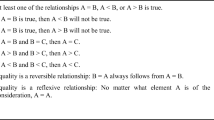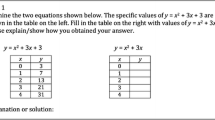Abstract
We use the notion offocusing phenomena to help explain how a teacher’s actions were connected to her students’ interpretations of a linear equation. This study was conducted in a high-school classroom that regularly emphasised dependency relationships in real-world situations. Seven interviews revealed a majority view ofy = b + mx as astorage container—a place to insert b and m values—rather than as a relationship between x- and y-values. Classroom analysis revealed how the teacher directed attention away from functional relationships with increasing frequency as she moved from realistic situations to conventional representations.
Similar content being viewed by others
References
Australian Education Council. (1990).A national statement on mathematics for Australian schools. Melbourne: Curriculum Corporation.
Bernard, H. E. (1988).Research methods in cultural anthropology. Beverly Hills, CA: Sage.
Bowers, J. S., & Nickerson, S. (2000). Students’ changing views of rates and graphs when working with a simulation microworld.Focus on Learning Problems in Mathematics, 22(3 & 4), 10–27.
Coxford, A. F., Fey, J. T., Hirsh, C. R., Schoen, H. L., Burrill, G., & Hart, E. W. (1998).Contemporary mathematics in context: A unified approach, Course 1, Part A. Chicago, IL: Everyday Learning Corporation.
English, L., & Warren, E. (1995). General reasoning processes and elementary algebraic understanding: Implications for instruction.Focus on Learning Problems in Mathematics, 17(4), 1–19.
Fey, J. T. (1990). Quantity. In L. A. Steen (Ed.),On the shoulders of giants (pp. 61–94). Washington, DC: National Academy Press.
Frorer, P., Hazzan, O., & Manes, M. (1997). Revealing the many faces of abstraction.International Journal of Computers for Mathematical Learning, 2(3), 217–228.
Glaser, B. G., & Strauss, A. L. (1967).The discovery of grounded theory: Strategies for qualitative research. Chicago, IL: Aldine Publishing Company.
Gravemeijer, K., Cobb, P., Bowers, J., & Whitenack, J. (2000). Symbolizing, modeling, and instructional design. In P. Cobb, E. Yackel, & K. McClain (Eds.),Symbolizing and communicating in mathematics classrooms (pp. 225–273). Mahwah, NJ: Lawrence Erlbaum.
Hershkowitz, R., Schwarz, B. B., & Dreyfus, T. (2001). Abstraction in context: Epistemic actions.Journal for Research in Mathematics Education, 32(2), 195–222.
Huntley, M. A., Rasmussen, C., Villarubi, R., Sangton, J., & Fey, J. (2000). Effects of standardsbased mathematics education: A study of the Core-Plus Mathematics Project Algebra/Functions Strand.Journal for Research in Mathematics Education, 31, 328–361.
Kaput, J. J. (1994). The representational roles of technology in connecting mathematics with authentic experience. In R. Biehler, R. W. Scholz, R. Sträßer, & B. Winkelmann (Eds.),Didactics of mathematics as a scientific discipline (pp. 379–397). Dordrecht, The Netherlands: Kluwer.
Kaput, J. J., & Nemirovsky, R. (1995). Moving to the next level: A mathematics of change theme throughout the K-16 curriculum.Undergraduate Mathematics Education Trends, 6(6), 20–21.
Kieran, C. (1993). Functions, graphing, and technology: Integrating research on learning and instruction. In T. A. Romberg, E. Fennema, & T. P. Carpenter (Eds.),Integrating research on the graphical representation of functions (pp. 189–238). Hillsdale, NJ: Erlbaum.
Lee, L. (1996). An initiation into algebraic culture through generalization activities. In N. Bednarz, C. Kieran, & L. Lee (Eds.),Approaches to algebra (pp. 87–106). Dordrecht, The Netherlands: Kluwer.
Lobato, J., Ellis, A., & Muñoz, R. (in press). How “focusing phenomena” in the instructional environment afford students’ generalizations.Mathematical Thinking and Learning.
Mason, J. (1996). Expressing generality and roots of algebra. In N. Bednarz, C. Kieran, & L. Lee (Eds.),Approaches to algebra (pp. 65–86). Dordrecht, The Netherlands: Kluwer.
Mathematical Sciences Education Board. (1998).High school mathematics at work. Washington, DC: National Academy Press.
Miles, M. B., & Huberman, A. M. (1994).Qualitative data analysis (2nd ed.). Thousand Oaks, CA: Sage Publications.
National Council of Teachers of Mathematics. (1989).Curriculum and evaluation standards for school mathematics. Reston, VA: National Council of Teachers of Mathematics.
National Council of Teachers of Mathematics. (2000).Principles and standards for school mathematics. Reston, VA: National Council of Teachers of Mathematics.
National Research Council. (1990).Reshaping school mathematics: A philosophy and framework for curriculum. Washington, DC: National Academy Press.
Nemirovsky, R., Tierney, C., & Wright, T. (1998). Body motion and graphing.Cognition and Instruction, 16, 119–172.
Orton, A., & Orton, J. (1994). Students’ perception and use of pattern and generalization. In J. P. da Ponto & J. F. Matos (Eds.),Proceedings of the 18th International Conference for the Psychology of Mathematics Education (Vol. 3, pp. 407–414). Lisbon, Portugal: PME Program Committee.
Pegg, J., & Redden, E. (1990). Procedures for, and experiences in, introducing algebra in New South Wales.Mathematics Teacher, 83(5), 386–391.
Reeuwijk, M. van (2002). Early school algebra: A Dutch perspective. In J. Kaput (Ed.),Employing children’s natural powers to build algebraic reasoning in the content of elementary mathematics. Manuscript in preparation. Available: http://www.simcalc.umassd.edu/NewWebsite/EABookChapters.html
Reeuwijk, M. van, & Wijers, M. (1997). Students’ construction of formulas in context.Mathematics Teaching in the Middle School, 2(4), 230–236.
Reid, D. (2002). Conjectures and refutations in grade 5 mathematics.Journal for Research in Mathematics Education, 33(1), 5–29.
Schatzman, L., & Strauss, A.L. (1973).Field research. Englewood Cliffs, NJ: Prentice-Hall.
Schliemann, A.D., Carraher, D.W., & Brizuela, B.M. (2001). When tables become function tables. In M. van den Heuvel-Panhuizen (Ed.),Proceedings of the XXV Conference of the International Group for the Psychology of Mathematics Education (Vol. 4, pp. 145–152). Utrecht, The Netherlands: Freudenthal Institute.
Sfard, A. (2000). Symbolizing mathematical reality into being—or how mathematical discourse and mathematical objects create each other. In P. Cobb, E. Yackel, & K. McClain (Eds.),Symbolizing and communicating in mathematics classrooms (pp. 37–98). Mahwah, NJ: Lawrence Erlbaum.
Stacey, K. (1989). Finding and using patterns in linear generalising problems.Educational Studies in Mathematics, 20, 147–164.
Stacey, K., & MacGregor, M. (1997). Ideas about symbolism that students bring to algebra.Mathematics Teacher, 90(3), 110–113.
Strauss, A., & Corbin, C. (1990).Basics of qualitative research: Grounded theory procedures and techniques. Newbury Park, CA: Sage Publications.
Streefland, L. (1995, April).Developing instructional activities in which algebra might arise naturally. Paper presented at the annual meeting of the American Educational Research Association, San Francisco, CA.
Szombathelyi, A., & Szarvas, T. (1998). Ideas for developing students’ reasoning: A Hungarian perspective.Mathematics Teacher, 91(8), 677–681.
Thompson, P. W. (1995). Notation, convention, and quantity in elementary mathematics. In J. T. Sowder & B. P. Schappelle (Eds.),Providing a foundation for teaching mathematics in the middle grades (pp. 199–222). Albany, NY: State University of New York Press.
Author information
Authors and Affiliations
Rights and permissions
About this article
Cite this article
Lobato, J., Ellis, A.B. The teacher’s role in supporting students’ connections between realistic situations and conventional symbol systems. Math Ed Res J 14, 99–120 (2002). https://doi.org/10.1007/BF03217356
Issue Date:
DOI: https://doi.org/10.1007/BF03217356




